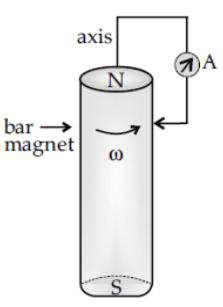A cylindrical bar magnet is rotated about its axis in the figure. A wire is connected from the axis and is made to touch the cylindrical surface through a contact. Then

(A) a direct current flows in the ammeter A.
(B) no current flows through the ammeter A.
(C) an alternating sinusoidal current flows through the ammeter A with a time period 2π/ω.
(D) a time varying non-sinusoidal current flows through the ammeter A.

(A) a direct current flows in the ammeter A.
(B) no current flows through the ammeter A.
(C) an alternating sinusoidal current flows through the ammeter A with a time period 2π/ω.
(D) a time varying non-sinusoidal current flows through the ammeter A.
(B) no current flows through the ammeter A.
The self inductance of long solenoid cannot be increased by
(a) increasing its area of cross section
(b) increasing its length
(c) changing the medium with grater permeability
(d) Increasing the current through it.
Two currents loops are concentric and lie in the same plane. The current in the outer loop is anti clockwise and increasing with time. The induced current in the inner loop ,is
(a) Clockwise
(b) Zero
(c) Counter-clockwise
(d) None of these
A conducting rod of unit length moves with a velocity 10 m/s in a direction perpendicular to its length and perpendicular to a uniform magnetic field of magnitude 0.2 T. The emf induced between the ends of the rod is
(a) 4 V
(b) 2V
(c) 1V
(d) Zero
A square loop of side l , resistance R is placed in a uniform magnetic field B acting normally to the plane of the loop. If we attempt to pull it out of the field with a constant velocity v , then the power needed is
(a) BRlv
(b) B²l²v²/R
(c) B l²v²/ R
(d) Blv/R
A vertical disc of radius 10 cm makes 10 revolutions per second about a horizontal axis passing through its centre. A uniform magnetic field 10⁻² T acts perpendicular to the plane of the disc. The potential difference between its centre and rim in volts is
(a) 3.14 × 10⁻² V
(b) 3.14 × 10⁻³ V
(c) 6.28 × 10⁻² V
(d) 6.28 × 10⁻³ V
There is a uniform magnetic field directed perpendicular and into the plane of the paper. An irregular shaped conducting loop is slowly changing into a circular loop in the plane of the paper. Then,
(a) Current is induced in the loop in the anti-clockwise direction
(b) Current is induced in the loop in clockwise direction
(c) AC Current is induced in the loop
(d) No current is induced in the loop
A coil of N turns and mean cross-sectional area A is rotating with uniform angular velocity ω about an axis at right angle to uniform magnetic field B. The induced emf in the coil will be
(a) NBAsinωt
(b) NBωsinωt
(c) NB/Asinωt
(d) NBAωsinωt
In an A.C. circuit, Irms and I₀ are related as
(a) Irms = p I₀
(b) Irms = 2 I₀
(c) Irms = I₀/p
(d) Irms =I₀ / 2
In a purely resistive a.c. circuit, the current
(a) is in phase with the e.m.f.
(b) leads the e.m.f. by a difference of π radians phase
(c) leads the e.m.f. by a phase difference of π/2 radians
(d) lags behind the e.m.f. by a phase difference of π/4 radians
In Young’s experiment with one source and two slits, one of the slits is covered with black paper. Then
(A) The fringes will be darker
(B) The fringes will be narrower
(C) The fringes will be broader
(D) No fringes will be obtained and the screen will have uniform illumination
The potential energy of a charged parallel plate capacitor is \(U_0\). If a slab of dielectric constant K is inserted between the plates, then new potential energy will be
(a) \(U_0\)/K
(b) \(U_0\)K²
(c) \(U_0\)/K²
(d) \(U_0\)²
A transformer having efficiency of 90% is working on 200 V and 3 kW power supply. If the current in the secondary coil is 6 A, the voltage across the secondary coil and the current in the primary coil respectively are
(a) 300 V, 15 A
(b) 450 V, 15 A
(c) 450 V, 13.5 A
(d) 600 V, 5 A
What happens if one of the slits, say S1 in Young’s double , slit experiment-is covered with a glass plate which absorbs half the intensity of light from it?
(a) The bright fringes become less-bright and the dark fringes have a finite light intensity
(b) The bright fringes become brighter and the dark fringes become darker
(c) The fringe width decreases
(d) No fringes will be observed
Two waves having intensities in the ratio of 9:1 produce interference. The ratio of the maximum to the minimum intensity is
I. 9:1
II. 4:1
III. 1:2
IV. 1:3
